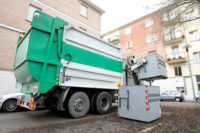Aprox card is a card is a card unless you do more things with it. And that’s what is happening as radio frequency identification (RFID) in its many increasingly powerful forms becomes a diverse security and business tool to apply to people, vehicles, assets and even processes. Active or passive, more or less intelligent, contact or contactless, with ranges from inches to feet, RFID is suddenly the super solution.
Most enterprise security leaders know RFID as the proximity card, contactless integrated circuit (IC) devices for security access or payment systems. Proximitycards are powered by resonant energy transfer. They are, at their basic, an automatic data collection solution. RFID systems consist of an RF tag – or a transponder: a radio receiver or transmitter that responds to an external signal by automatically transmitting a signal – and an RF reader/controller.

|
|
RFID tags are a growingly essential tool in healthcare facilities to security expensive assets and track inventory. |
But it is the smarter RFID solutions to identify people, cars, assets and procedures that bring the technology to life for enterprises, their security executives and others.
Cards come in passive and active versions as well as PSK (Phase Shift Keying) and ASK (Amplitude Shift Keying) formats, MIFARE and HID-compatible cards. Each has its own technical and application advantages. Readers, of course, must match the card technology. Readers can also include PIN, keypad or biometrics, in addition. But don’t forget the security. For instance, readers, cards and tags using a digital encryption algorithm deliver a needed level of communications security between the cards and readers.
Diverse Types of RFID Tech
MIFARE is reputedly the most widely installed contact less smartcard, or proximity card, technology in the world with more than 1 billion smart card chips and 10 million reader modules installed. The technology is owned by NXP Semiconductors. MIFARE contactless technology, more popular outside the U.S., is used in many different applications including public transportation, access management, event ticketing and customer loyalty. With sources such as RF Logics carrying the cards and readers, MIFARE use will increase.
Another indication: LEGIC Identsystems says it will support MIFARE technology in its reader platforms.
Still, technology is nothing without its applications and there are plenty when it comes to RFID. Proximity cards and to a lesser degree contactless smartcards are typical when it comes to door access control. But, when it comes to vehicle and parking security applications, longer read range passive RFID comes into play. For example, Schorr has a two-side printable passive long range card that does not require a battery and has a read distance of 15 feet.
Some RFID tags do have batteries, and that can reduce the life of the investment. There are some active tags with replaceable batteries, as well.
Still, just as use of security video has gone beyond security, RFID has itself become a tool with myriad people and asset applications.
For example, in healthcare facilities, RFID systems can provide real-time patient safety and security monitoring solutions. Some systems aim at protection of ambulatory individuals suffering from Alzheimer’s disease and dementia or other high risk residents and patients who exhibit the tendency to wander off unnoticed. The approach permits regular movement of care givers, guests, other residents or family members through a protected doorway while preventing unsupervised “wanderers” from leaving protected areas. Should a high risk resident or patient approach the door through which they are not allowed to pass unescorted, an automatic alert functionality immediately triggers.
A model program at the University of Chicago Medical Center gives caregivers RFID-enabled badges to wear and which monitor hand hygiene events upon entering and exiting a patient room. The system also includes communication screens in each patient room that can display hospital- or patient-specific information. The initiative aims to improve hand hygiene quality and compliance monitoring. The technology is a “smart” touchless system that monitors compliance without any disruption to workflow. The Centers for Disease Control, the Joint Commission, World Health Organization and other healthcare-related organizations are placing increasing emphasis on the importance of effective hand-hygiene compliance to help reduce the spread of infection.



